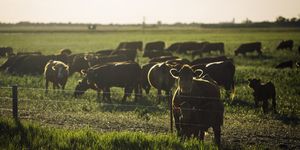Fall was in the air that September, and the grizzly bears I was attempting to photograph in the Beartooth Mountains were hungry, getting ready for their long winter's sleep. A week had already gone by since the last time I had gotten anything close to a useable picture.
Waking up, making coffee, and telling myself that today would be the day I got the frame was my routine. Then out into the field to fix my camera traps, hiking from one to the next, and repeat.

I walked along the edge of the lake to check on a recently placed trap, thinking about all of the problems that a bear creates as it raids stashes of pinecones buried by red squirrels for their winter reserves of food. A bear gorging itself on pine nuts doesn't think twice about my tiny little camera that just might be in its way, and more often than not I would show up to check a site and find my camera traps destroyed by the ravenous bears.
Working with camera traps is a lesson in patience and guts. You have to be able to tell yourself that eventually it's going to happen, and you have to have to perseverance to fix repeated problems while knowing that in all likelihood those problems are going to happen again.
At its simplest, the setup consists of a camera, a trigger, and the promise of disappointment. You do everything you can to make sure the camera box is securely positioned, that the animal will trigger the camera exactly where you expect it to, that the lighting you have meticulously placed to freeze the movement of feeding bears is perfect-only to find that either nothing had walked through it, a squirrel had chewed the cables, a dead branch had fallen and knocked over the camera box, or, as was happening most often, the traps had been destroyed by ravenous bears-and you didn't get any pictures.
While checking my cameras that day, I had no interest in running into any of these bears as they filled their bellies, so I made as much noise as I could as I went, hollering and banging as a precaution to scare away any that might be nearby.
Suddenly a grizzly exploded in the thick brush just beyond the lake's edge. She must not have heard me coming.
"Hey, hey!" I yelled at the top of my lungs as I stumbled in surprise. The brush was so thick that I could only hear her as she was crashing toward me, huffing and snapping her jaws. About 15 yards away, she turned and crashed through the woods in the opposite direction, right around the same time that I was finally able to get the safety off the trigger of my bear spray.
I walked backward the entire distance back to my four-wheeler, shaking, expecting to see her charge out of the brush again in my direction. Luckily I didn't. My heart was beating out of my chest. I took the rest of that day off, my mind questioning what exactly I was doing here at 10,000 feet, going looking for grizzlies.
Finally, in the first part of October, I get to a trap and it is intact. There's fresh digging in front of the camera. I check the trap by triggering it ... it works. I open the back of the camera box and press play, and to my surprise I'm greeted by an image of a grizzly digging and eating pine nuts. Got it.
Drew Rush photographed grizzly bears for an April 2015 National Geographic magazine story looking at the devastating effects of the mountain pine beetle on forests-and ecosystems-in the northwestern United States and Canada. He is also a recent National Geographic Expeditions Council grantee.
You might also like this post about using camera traps to photograph big cats: Through Steve Winter's Lens, Big Cats Step Into the Limelight
(Source: National Geographic)









